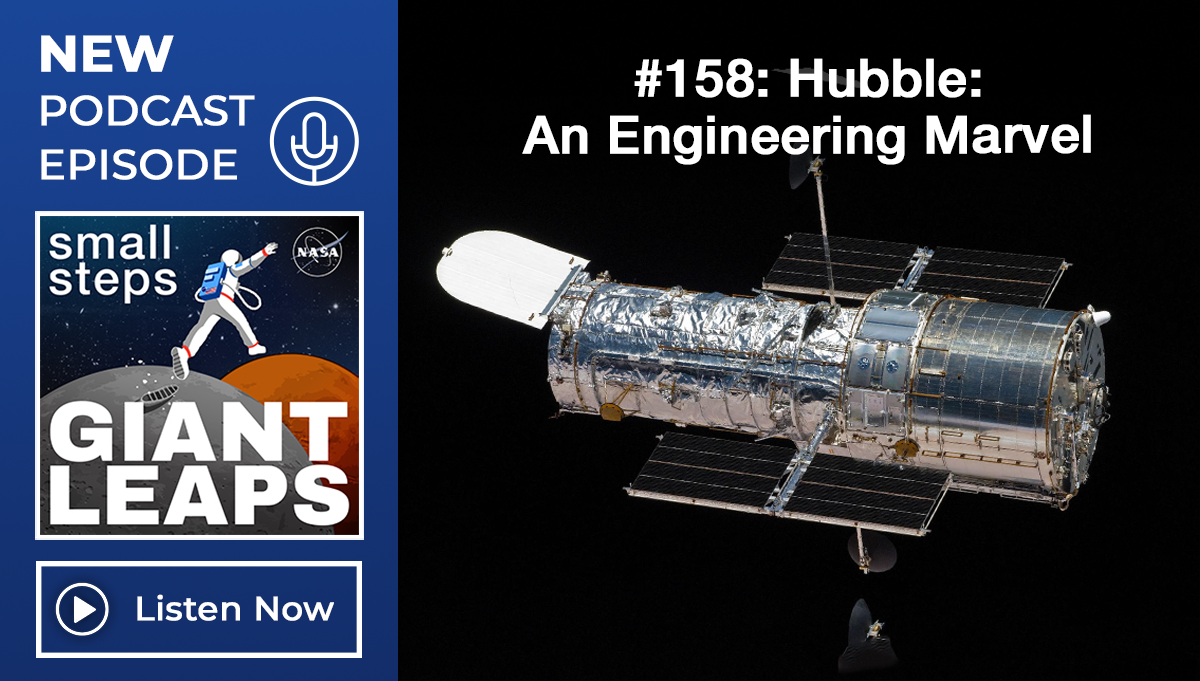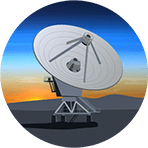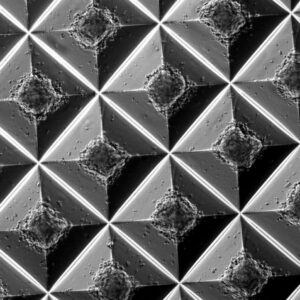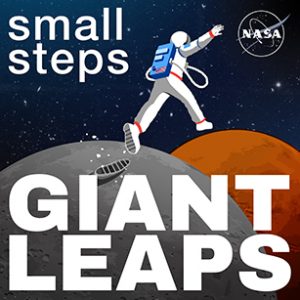Research breakthroughs that keep astronauts healthy in space are also transforming medicine here at home.
What if we could get rid of lengthy waitlists for organ transplants? Well, imagine 3-D printing a kidney from your own stem cells. That would reduce the chances your body rejects it. That’s the sort of groundbreaking medical research astronauts are conducting aboard the International Space Station. Other research includes understanding the stress spaceflight places on not just the body, but also the mind. There’s a plethora of human factors to consider as humanity prepares to embark on deep space missions. What we learn from spaceflight medicine could also transform lives here on Earth. Dr. J.D. Polk, NASA’s chief health and medical officer, tells us what’s on the horizon in space medicine.
In this episode, you’ll learn about:
- Human health research under way in space
- How behavioral health connects to physical health
- Medical spinoffs benefiting people on Earth
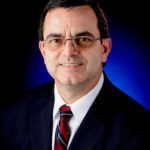
Credit: NASA/Joel Kowsky
Dr. James D. Polk is NASA’s chief health and medical officer at NASA Headquarters in Washington. He began serving in this position in November of 2016.
Formerly the dean of medicine for Des Moines University’s College of Osteopathic Medicine, Dr. Polk was the acting assistant secretary for health affairs and chief medical officer of the U.S. Department of Homeland Security (DHS), assuming this post after serving as the principal deputy assistant secretary for health affairs and deputy chief medical officer. Before DHS, Dr. Polk was the chief of space medicine for NASA’s Johnson Space Center in Houston. He has also served as the state emergency medical services medical director for the state of Ohio. Dr. Polk is a fellow of the American College of Osteopathic Emergency Physicians, fellow of the Aerospace Medicine Association, and fellow of Extreme and Wilderness Medicine.
Resources
NASA Spinoff Technology
NASA’s Human Health and Performance Directorate
The Human Body in Space (Article)
3D Bioprinting (Article)
Dr. James D. Polk’s Biography
Houston, We Have a Podcast episode – Spaceflight Adaptation
Courses
Foundations and Practice of MBSE & SysML (APPEL-MBSEFP)
Transcript
Andres Almeida (Host): Welcome to Small Steps, Giant Leaps, the podcast from NASA’s Academy of Program/Project & Engineering Leadership or APPEL. In each episode, we dive into the lessons learned and experiences of the people behind NASA’s innovative missions and research.
What if we could get rid of organ donation waitlists? Well, imagine 3-D printing a kidney from your own stem cells. That would reduce the chances your body rejects it. And that’s the sort of groundbreaking medical research astronauts are conducting aboard the International Space Station. Other research includes the stress of spaceflight on not just the body, but also the mind. There’s a plethora of human factors to consider as humanity prepares to embark on deep space missions. What we learn from spaceflight medicine could transform lives here on Earth.
Joining us to talk about it is Dr. J.D. Polk, NASA’s chief health and medical officer. He oversees health at NASA, including for astronauts before, during, and after a mission to space.
Hey, J.D., thanks for joining us.
J.D. Polk: Hey, my pleasure.
Host: Can you tell us more about your role?
Polk: Yeah, it’s a little unique. I’m the chief health and medical officer for the agency, which oversees all the healthcare for not only the all the employees at all the different NASA centers, but also the astronauts and the space missions that NASA deploys.
But I’m also the health and medical technical authority, which means I weigh in on the technical aspects of human factors and human systems integration as it applies to vehicles, with the, you know, the primary outcome of trying to protect the crew and make sure that the mission and the crew both are successful.
Host: What makes protecting the crew particularly challenging in regards to their health and wellbeing?
Polk: Yeah, that’s a great question. You know, first one, they’re selective. They’re a pretty healthy cohort. We cheat a little bit right off the top, and we select folks that are pretty healthy to begin with. But spaceflight is pretty tough.
You know, the microgravity causes fluid shifts to where that fluid that’s up in your lower extremities and your, the bottom half of your body moves up into your head and torso. Your body just doesn’t like all that blood up and it’s in the head. And you can see what we call SANDS, which is spaceflight associated neuro-ocular syndrome. That’s a mouthful, but what that really is, is some swelling of the optic nerve and maybe a little bit of mild brain tissue swelling as well that causes changes in the vision of an astronaut.
And also, we can see what’s called stasis, or a lack of flow in the internal jugular vein, for folks that, uh, have smaller internal jugular veins on the left side, and we’ve seen a couple of clots in that vein, and that’s – think about like a DVT [deep vein thrombosis]. We’ve all heard about DVTs, if you’re flying on a plane and you don’t move about, so well, this is kind of the opposite. This is a DVT, but instead of in your lower extremities, it’s up in your neck where that blood can then back up, all that fluid can back up into your head and your brain. And so those are some pretty dangerous things (that last one in particular).
We monitor the astronauts and we’re always trying to keep them as healthy and optimized on orbit as possible. But those are some of the things that keep us awake at night: This optic nerve edema and also this thrombosis or clot that can occur. We’ve only seen it twice but twice is too many times for me. I’m, it’s a worrisome entity.
But you also see changes in bone, bone loss. If you’re not putting a lot of pressure through your bones, you can see changes in the muscle, what we call muscle morphology, switching to fast twitch fibers in the lower extremities. So, there’s a host of changes that occur even in the immune system and other places. So, keeping the astronauts healthy in space is a difficult job, but it helps it the that we start with pretty good protoplasm to start with.
Host: What are some recent advancements have been made and understanding how, just how microgravity affects the body?
Polk: Yeah, you know, the data that we get down the astronauts are really good at doing many of the exams. And we’ve gotten ultrasound data. We’ve gotten data on what we call OCT, which is ocular coherence tomography, looking at the back of the retina. We get data down on the amount of calcium that they are spilling in the urine to see if they’re losing calcium from the bone.
We have an enormous amount of data that we get down, and I think that’s probably one of the greatest benefits of the International Space Station, is we’ve been able to get a host of different physiologic data that give us insight to what we will need to mitigate and what challenges we’ll have for a mission to Mars, for example.
And then the Moon itself is a great testbed, being 1/6 g, pretty much anything that’s going to work in one 6 g as a countermeasure will work in 1/3 g of Mars, if it’s g-related with the fluid shifts, etc. So that, you know, we probably won’t see SANDS on the Moon. Those missions will be about 30 days, and we usually don’t see a vision change in the astronauts till about the second month or third month.
But we do see changes in the OCT, the subtle changes in the back of the eye prior to any clinical changes or any noticeable vision change in the astronauts. So, those two things together, the Artemis missions going to the Moon and the ISS long-duration missions, give us great insight to what we will need to do for Mars, for that six-month travel to the planet, and then how helpful the gravity of the planet will be, and then, of course, the travel back. And so, it’s, it’s been incredibly insightful.
It’s like, it’d be like breaking down a vacation if you were going somewhere for three days, but you’re breaking it down into segments to learn about each part of that journey. So, it’s been fascinating from a physiologic standpoint.
Host: Our colleagues at Houston, We Have a Podcast delved into this topic with J.D. Take a listen: Episode 370 at nasa.gov/podcasts or anywhere you listen to podcasts.
J.D., would you say these changes to the body are like aging, similar to aging on Earth?
Polk: Yeah, that’s a great question. You know, some things look very much like aging, certainly radiation can, you know, look like they’re aging cells, and the bone loss itself can mimic osteoporosis that we see in the elderly. And so, there’s a host of things that we do there. Your nutrition is one, you know, getting enough vitamin D and your nutrition.
And then resistive exercise is one that we’ve deployed with great success on the International Space Station. And resistive exercise helps a great deal, whether you’re elderly and trying to maintain bone health, or whether you’re a young astronaut in microgravity trying to maintain bone health, that pressure through the bones with resistive exercise helps the bones, the integrity of the bones, stay together, and the strength or trigger of the bones. And we call that Wolff’s Law. And Wolff’s Law pretty much states your bones grow according to the pressures placed upon them.
So, if you’ve ever broken a bone, let’s say if you ever fractured a lower extremity bone, for example, and you were on crutches, you probably noticed that your doctor said, “No, no weight on that bone for the first couple of weeks.” And then you were allowed to put your foot down gradually and do just partial weight bearing. And then by the end of six weeks, you’re doing full weight bearing. And that’s, that’s Wolff’s law in action. You’re, you’re placing pressure through the bone. And then what’s called the osteoblasts. The osteoblast cells know where to lay down in bone based on that pressure. There’s an electrochemical feedback from the bone as a living organism, that bone, when it has pressure through it, it starts to build up more bone in those areas that that take on that load.
And so, you know, we’ve learned that to both with elderly patients. So, we’ve learned that with people with fractures, but we also apply that same rigor and that same law to astronauts working and exercising in space.
Host: Going back to radiation, are there any promising developments in radiation shielding science?
Polk: Yeah, there are promising developments in both shielding and material science. You know, hydrogen is probably the best material to block radiation, and we’ve learned a lot about blocking radiation from solar radiation, galactic cosmic radiation is a heavy, high energy transfer particle that’s a little harder to block.
And so, we’ve, you know, we’ve been looking at things like active radiation shielding. Could you, could you change the magnetic poles around a spacecraft or create a magnetic field around a spacecraft that would at least deflect some of those radiation particles? Right now, that requires a large amount of energy, but the, but the science is there, and it’s conceivably possible. And then probably one of the biggest things that really help us with radiation is not any type of chemical or material to block it but actually increasing the speed at which we transit from Earth to Mars.
So, the engineering community with more higher-developed engines and the ability to shorten that distance from point A to point B actually helps more than anything else, because you’re, when you’re in deep space, that’s when you are exposed to that galactic cosmic radiation with those high energy transfer particles that can damage DNA when they slam through your tissue.
There’s three things that usually help with radiation: time, distance and shielding. and we’re working on, certainly decreasing the time of exposure by increasing the three throughput of the engines and the speed of the engines to get there faster.
And then, shielding is another one that we’re working on as well, but then also working on the back end to see, you know, on repair of cells. And if we can find, whether it’s through nutrition or pharmaceuticals, things that may help with DNA repair and help the body repair itself as well. So, lots of science going and going on in all of those areas.
But probably the engineering community, with their ability to advance the engine prototypes, is one of the biggest things that we’re looking at as well.
Host: What about spinoffs, medical research spinoffs that are helping people on Earth. What are some examples of some?
Polk: Oh yeah. Boy, there’s a ton. There’s things that we develop for spaceflight, and then there’s things that we help folks or push them along to develop a little further, that things are that were already on the ground, but we, we’ve we advanced them, either through materials science or other science, there’s a host of different things.
Most people don’t realize even a smoke alarm in your house came from the Skylab Program. But for medical, certainly, there’s different things that we look at. There’s algorithms and software that we use to look at a hundreds of shades of gray for a planetary mission if you’re taking photos and images, and that same algorithm and software can be applied to ultrasound on the ground, looking at all the different shades of gray when you’re looking at tissues to identify you know, what is, what is, potentially cholesterol in a[n] artery.
And then, you know, you go even further afield to something like 3D printing and 3D-printing of tissue. Redwire used the BioFabrication Facility on the International Space Station over this last year to produce a human knee meniscus on orbit, and also beating cardiac cells and 3D-printed those.
Now you might wonder why would you do that on orbit? Well, the cells stack a little bit more readily in microgravity. There are different crystalline structures that we can produce in microgravity that you can’t produce on the ground and being able to 3D-print a matrix without gravity, having those cells settle or smash each other – what’s called “senescence.”
And so, if you think about that, I mean, being able to 3D-print a knee meniscus from your own stem cells, you know, that changes medicine drastically on the ground in the next decade or two. And having cardiac cells that you could 3D-print, it opens up some areas of science that a lot of people don’t think about.
And probably, probably the best example of that would be organ transplant. You know, there are probably, right now in the country, there’s a 10-year-old waiting for a new kidney or a new liver or a new heart, and unfortunately, somebody has to meet an untimely end for that, that child to have an organ available to them. And no one wishes, you know, no parent wishes ill on another family or a tragedy on another family so that their child can benefit. It’s a, it’s a tough and stressful situation to be in. They’re hoping for a heart or a liver or a kidney, but they don’t want ill will to come about to make that available.
But the 3D-printing of tissues and using stem cells as the matrix for that tissue – so imagine being able to now take that 10-year-old’s cells, spin them down, take the stem cells, grow and culture those stem cells, program those stem cells to become a particular organ, and then 3D-print the matrix of that organ so that now the child, instead of waiting for disaster to happen to another family, gets a transplant of a liver or a kidney or a heart that’s actually made of their own stem cells.
And right now, when you get an organ transplant, you’re on a host of medications to prevent rejection for your lifetime, which can wreak havoc on the body, and there’s a risk for infection and other things that occur. But if you can imagine now that 10-year-old gets their transplant and does not have to have a host of medications for rejection because it was made from their own stem cells.
Yeah, a lot of that science of what is possible with shell matrices and microgravity is being done in concert with Redwire and other companies. And the microgravity environment of ISS just a great platform to try those things out.
Host: 3D printing has come such a long way. What about 3D-printing of medications?
Polk: Yeah, the 3D-printing of medications. We went to University College of London to talk to their folks. There’s certainly people in the United States working on this as well. But you know, when I go to Mars, I can’t take the entire pharmacy with me. I can’t take CVS and Walgreens with me. There’s just too much mass, etc. So, you know, we try to contemplate what medications we would need. But also, we’ve been looking at, okay, if I can’t take the thousands of medications with me, could you take the constituent chemicals needed to make those medications?
And there’s, you know, there’s an acronym that we use in the bio sciences and such that that talks about all the different chemicals that typically make up tissues and make up medications and other things of that nature. And a lot of it is, you know, the carbon, hydrogen, oxygen, magnesium, sulfur, phosphorus. And there’s a host of chemicals, but there really is only about 12 to 14, but in different combinations. And so rather than taking all these medications with me, could I take the constituent chemicals? And if you know the recipe for, say, you know, Cipro or amoxicillin, that you could build that medication and then 3D-print it a just-in-time manner. And so, there’s a lot of implications for what may occur on the ground with that technology. And it’s getting closer. We’re watching where it’s evolving.
The thing that’s always exciting to me, is then to go and talk to these folks and tell them what you’re trying to do on an exploration mission, and spaceflight was nowhere on their radar whatsoever. But then they start looking at this and looking at the implications, and looking at what they might be able to do and what would be required to advance that technology and it, it often kickstarts some things in a direction that that, of course, has, you know, cascades down to the ground as well, and benefits folks in hospitals and communities on the earth as well.
Host: I’d love to dive a little bit into mental wellness which is also important. So, what strategies or technologies NASA exploring to support astronauts on, say, long missions where mental health does have its challenges?
Polk: Yeah, you know, probably one of the biggest things we’ve learned there, there’s two things that I think are really important. One: You can’t underestimate the power of physical exercise.
Almost to a T, all the, all the astronauts state that they feel mentally better, you know, when they are been active on the ARED [Advanced Resistive Exercise Device] and the treadmill, and the TVIS [Treadmill with Vibration Isolation Stabilization], the bike, etc., That that ability to work out, whether it’s the endorphins, the enkephalins, the exercise, the blood pumping, whatever it is, dopamine surge that occurs with all of those – they feel physically and mentally better with exercise. That’s probably first and foremost.
But then also connectivity. Relationships matter, whether, you know, relationships on the ground, with family, with friends and so keeping that kind of connectivity, the ability to reach back and talk to family, even if it’s voice notes or if it’s real time, letters from home by email or what have you, that connectivity, knowing what’s going on with family and friends, and that sharing and the connectivity on orbit with their colleagues when they have downtime, you know, playing music or doing whatever that that gives them some joy in their downtime. That helps immensely.
And then there’s the small things: food. I mean, a lot of us get joy from food as well our favorite foods. Some of the astronauts would mention that when the Progress would come up and have fresh fruit that the Russians had brought up on the Progress, so when you open the hatch, just that smell of the fresh fruit was amazing.
And so, you try to activate and work on those different areas, the connectivity, the exercise, the things that bring them joy, to allow them to cope with the, you know, the isolation of spaceflight. Certainly, they’re very mission-driven individuals, and they are focused on the mission at hand, and they, that also, that ability to execute and complete that mission also gives them some satisfaction. But, you know, those are some things that we’ve learned.
But when you go back and look through history, whether it was finding the Northwest Passage or whether it was Shackleton’s missions down in the Antarctic, it’s the same. It’s that having that purpose, having physical activity, connectivity. Those hallmarks are not necessarily new science there. They may be rediscovered recently, but when you go back and look through the journals from Dr. Cook or from other folks on Shackleton’s missions or the Northwest Passage, there’s some repeating themes there.
Host: I love that. You’re also in osteopathic medicine. What drew you to that and how is it applied to crew before, during, and after a mission?
Polk: Yeah, I guess what drew me, I was in physical therapy before and so, you know, I migrated to osteopathic medicine. Even though I was going to be an emergency physician, I wanted that kind of, that holistic mindset. And I would guess that’s probably what we use often in spaceflight as well. When I say holistic, you know, you can go to the doctor and you can get a prescription when you’ve got a cold or, you know, a sinus infection or what have you, but really, the goal is to prevent illness and to maintain wellness.
And so, you know, talking to the crews and getting an idea of what their diet is, and and we, we do a lot to augment their diet to make sure that they’ve got the right vitamins and minerals and the right antioxidants in their food. And then that exercise, like we talked about, what a vital component that is, and and then relationships. If you’re having a bad relationship, you’re in a poor marriage, or a poor relationship at home, you’re probably physically manifesting that stress in some ways as well.
And so, it’s what we find, is that it’s a very holistic thing. It’s part genetic, part physiologic, with exercise and part diet and nutrition. It’s all of those things together that play into your, your general wellness and that keep you “healthy.” And I think that’s very much an osteopathic mindset, to look at all the parameters of someone’s life as it goes into their health, not necessarily just writing out a prescription.
Host: What are some of the next big questions that NASA hopes to answer in human health research in space?
Polk: Wow. Well, one of the things that we’re looking at is, can I prevent things like SANDS or that thrombosis? Can well, will partial gravity, you know, with a 1/6 g of the Moon, be enough to pull that fluid, enough fluid down from the head and thorax to prevent SANDS. Or will a medication? And there’s a couple of medications that we’ve been looking at that might lower intracranial pressure. That might be a benefit. And can I prevent those clots from occurring, whether that’s with movement, lower body, negative pressure, with medications, you know, something that might be a low dose platelet inhibitor, any of those things that might mitigate some of those top risks.
And then also, you know, as we look at things like 3D printing and 3D-printing of organs and 3D-printing of medications and and furthering the science to allow us to execute these exploration missions. It’s exciting to see the potential that it has, although it may have its initial manifestation or birth in spaceflight, to see where it may change or cascade things on the ground.
And a lot of folks may not know that it ever came from spaceflight. Yeah, it’s your smoke alarm, certainly at your home doesn’t have a sticker on it with the NASA meatball on it that says, “invented by NASA.” Or in many of the fuel cells that we see in cars don’t say, “Hey, by the way, that was perfected in the Apollo Program.”
All the things that we learn along the way as we try to do tech development, science development, and learn about ourselves, our own physiology and our own psyche and that exploration journey. I think it’s an exciting time for Artemis, and those are the things that we’re looking forward to.
Host: J.D., what was your giant leap?
Polk: I would say my giant leap was probably coming to NASA in the very beginning. I was an emergency physician at a level one trauma center and the chief of Life Flight [Network], and we had just built our nice, big doctor house and this was something I wanted to go do. I wanted to go get involved in space medicine and spaceflight, and it was going to be a risk, and it was going to be a pay cut. And it was going to be tough on my family, because I was going to be deployed to Russia for many months at a time as we were developing the International Space Station and building it.
And fortunately, I have a spouse that said, “You know what, you need to go take the leap.” And so, that was probably my biggest giant leap, and here we are, 20 years later, and I don’t regret it for a day. It was – I always find it fascinating to be here, and I am certainly fortunate to be in the job that I’m in.
Host: J.D., thank you for sharing your time with us today.
Polk: No. Thank you. I appreciate it.
Host: That’s it for this episode of Small Steps, Giant Leaps. For more on Dr. J.D. Polk and the topics we discussed today, visit our resource page at appel.nasa.gov. That’s A-P-P-E-L dot nasa dot gov. And don’t forget to check out our other podcasts who are coming back with new seasons this year. That’s Curious Universe, Houston, We Have a Podcast, and Universo Curioso de la NASA, NASA’s first Spanish-language podcast. Thanks for listening.
Outro: This is an official NASA podcast.




